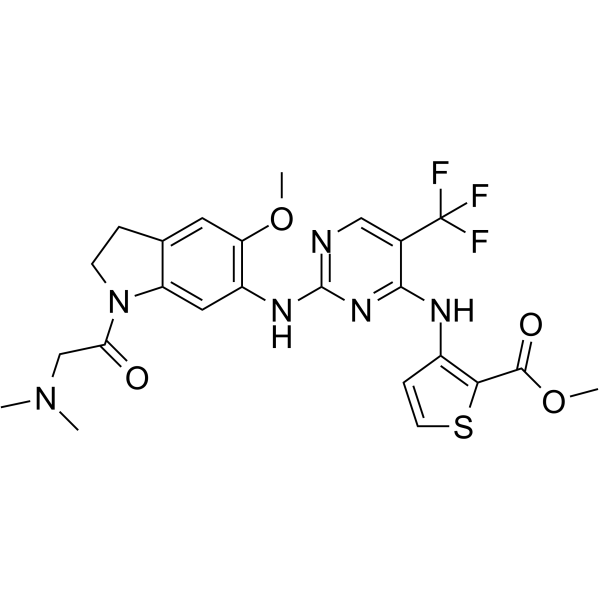| In Vitro |
PLK1-IN-4 (compound 31) (0-5 μM; 48 hours) exhibits excellent antiproliferative activities against HCC cells[1]. PLK1-IN-4 (60 and 100 nM; 24 hours) induces abnormal spindle formation in HepG2 and HT-29 cells[1]. PLK1-IN-4 (10-300 nM; 0-48 hours) induces apoptosis in cancer cells through G2/M arrest[1]. PLK1-IN-4 (0-120 nM; 24 hours) increases phosphorylation of PLK1, histone H3 and NPM and decreases phosphorylation of Cdc2 in a dose-dependent manner[1]. Cell Proliferation Assay Cell Line: MDA-MB-231, HeLa, HCT 116, HT-29, HepG2, SMMC7721, A549 ,JeKo-1,K562, Karpas299, A375, DU-145 and L02[1] Concentration: 0-5 μM Incubation Time: 48 hours Result: Exhibited excellent antiproliferative activities against HCC cells, with IC50s of 11.1 nM and 70.9 nM in HepG2 and SMMC7721 cells. Cell Cycle Analysis Cell Line: HepG2[1] Concentration: 10, 30, 60, 100 and 300 nM Incubation Time: 0, 12, 24, 36 and 48 hours Result: Induced apoptosis in cancer cells through G2/M arrest. Western Blot Analysis Cell Line: HepG2[1] Concentration: 0, 10, 30, 60, 90 and 120 nM Incubation Time: 24 hours Result: Increased phosphorylation of PLK1, histone H3 and NPM and decreased phosphorylation of Cdc2 in a dose-dependent manner.
|
| In Vivo |
PLK1-IN-4 exhibits low metabolic stability in species of human, mouse, dog and monkey, with CLhep of 74.3, 330.9, 61.5 and 196.5 mL/min/kg, respectively[1]. PLK1-IN-4 (30 mg/kg; tail vein injection; once or twice daily, for 12 days) suppresses tumor growth in a dose dependent manner[1]. Pharmacokinetic Parameters of PLK1-IN-4 in male ICR mouse[1]. IV (5 mg/kg) C0 (ng/mL) 1790 T1/2 (h) 1.47 MRT0-inf (h) 0.808 MRT0-t (h) 0.704 AUC0-t (ng·h/mL) 767 AUC0-inf (ng·h/mL) 776 CL (mL/min/kg) 107 VdSS (L/kg) 107 Animal Model: Male nu/nu BALB/c mice (4-6 weeks; injected with HepG2 cells)[1] Dosage: 30 mg/kg Administration: Tail vein injection; once or twice daily, for 12 days Result: Suppressed tumor growth in a dose dependent manner, and the tumor growth inhibition (TGI) values were 120.0% and 135.2% at doses of 30 mg/kg once daily and 30 mg/kg twice daily, respectively. Animal Model: ICR mouse[1] Dosage: 5 mg/kg Administration: IV; single (Pharmacokinetics Analysis) Result: Exhibited a short half-life (T1/2) of 1.47 h, moderate exposure with an area under the curve (AUC0-inf) of 776 ng·h/mL and volume of distribution at steady state (Vdss) of 5.21 L/kg.
|
